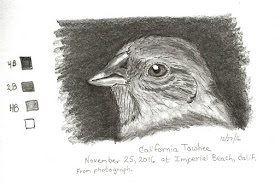In 1973 a half dozen forms of juncos, formerly all treated as separate species, were all lumped as one: and thereafter known as the Dark-eyed Junco. Because they look quite different from one another, birders often report the various forms with their previous names--even after 45 years.
Recently I found a flock of juncos in San Diego County that contained several forms: Oregon, Slate-colored, Cassiar, and Gray-headed. If I looked longer I may have been able to find Pink-sided, too, to complete all the forms expected in the county. The Oregon form is a resident of the San Diego mountains and a common winter visitor throughout the county. The other forms mentioned above are numerically rare, but regular annually in winter.
I was able to successfully photograph the Oregon, Slate-colored, and Gray-headed forms on a recent morning visit to Oak Hill Memorial Park Cemetery in Escondido. I was not able to get a photo of the Cassiar Junco that was also present. It is a disputed form, some think it a hybrid between Oregon and Slate-colored, others disagree. [See:
Not a Slate-colored Junco! The Cassiar Junco.]
 |
| "Oregon Junco" |
 |
| "Slate-colored Junco" |
 |
| "Gray-headed Junco" |
 |
| "Gray-headed Junco" |
My favorite form right now is the Gray-headed Junco, because it is a form I have rarely seen before. It breeds from southern Idaho and Wyoming to northern Arizona and New Mexico. It is resident in the Grand Canyon area. It is regular, but rare in winter here in the San Diego area. In fact, the only Dark-eyed Junco forms north of Mexico that aren't regular here in winter are White-winged and Red-backed.

































